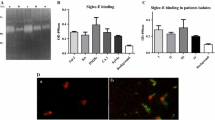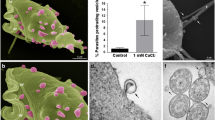Abstract
In the present study the parental cells and glycosylation mutants of Chinese hamster ovary (CHO) cells were used to analyze the influence of surface carbohydrates on the cytoadhesion of trichomonads.Trichomonas vaginalis andTritrichomonas foetus were allowed to interact with host cells for 2 h at 37°C. Alternatively, CHO cells were treated with 10 mM periodate prior to the assays. Both trichomonads adhered to all CHO cell clones tested. A remarkable difference could be observed between the cytoadhesion ofT. vaginalis andT. foetus. Sialic acid residues present on the surface of CHO cells may favor the cytoadhesion ofT. foetus while hampering that ofT. vaginalis. The specificity of the parasite cytoadhesion was further investigated. Sialic acid, mannose, and galactose as well as mannose, galactose, andN-acetylglucosamine added to the interaction medium at 50, 100, and 200 mM were capable of significantly inhibiting the cytoadhesion of each trichomonad species. Periodate treatment of target cells also induced decreases in the cytoadhesion of the trichomonads. These results strongly sugest an important role for host-cell surface glycoconjugates during the cytoadhesion of trichomonads. In addition, they also point out the presence of “lectin-like” molecules on the surface of bothT. vaginalis andT. foetus.
Similar content being viewed by others

References
Alderete JF, Garza GE (1985) Specific nature ofTrichomonas vaginalis parasitism of host cell surfaces. Infect Immun 50:701–708
Alderete JF, Garza GE (1988) Identification and properties ofTrichomonas vaginalis proteins involved in cytoadherence. Infect Immun 56:28–33
Alderete JF, Pearlman E (1981) PathogenicTrichomonas vaginalis in epithelial cell cultures. Br J Vener Dis 57:106–117
Araújo-Jorge TC, Souza W de (1988) Interaction ofTrypanosoma cruzi with macrophages. Involvement of surface galactose andN-acetyl-D-galactosamine residues on the recognition process. Acta Trop (Basel) 45:127–136
Azevedo NL, Silva Filho FC, Souza W de (1991) The interaction ofTritrichomonas foetus andTrichomonas vaginalis with macrophages. J Submicrosc Cytol Pathol 23:319–326
Benchimol M, Batista C, Souza W de (1990) Fibronectin and laminin-mediated endocytic activity in the parasitic protozoa (Trichomonas vaginalis andTritrichomonas foetus. J Submicrosc Cytol Pathol 22:39–45
Bonilha VL, Silva Filho FC (1990) Interaction of TPA-treated trichomonads with fibronectin-coated substrata. Mem Inst Oswaldo Cruz 86 [Suppl III]:123
Burgess DE, McDonald CM (1992) Analysis of adhesion and cytotoxicity ofTritrichomonas foetus to mammalian cells by use of monoclonal antibodies. Infect Immun 60:4253–4259
Corbeil LB, Hodgson JL, Jones DW, Corbeil RR, Widders PR, Stephens LR (1989) Adherence ofTritrichomonas foetus to bovine vaginal epithelial cells. Infect Immun 57:2158–2165
Demes P, Pindak FF, Wells DJ, Gardner WA Jr (1989) Adherence surface properties ofTritrichomonas mobilensis, an intestinal parasite of the squirrel monkey. Parasitol Res 75:589–594
Diamond LS (1957) The establishment of various trichomonads of animals and man in axenic cultures. J Parasitol 43:448–490
Dias Filho BP (1992) Componentes de superfície em tricomonadídeos: açúcares emTrichomonas vaginalis e glicoconjugados emTritrichomonas foetus. PhD Thesis, Universidade Federal do Rio de Janeiro, Rio de Janeiro
Farthing MJ, Pereira MEA, Keusch GT (1986) Description and characterization of a surface lectin fromGiardia lamblia. Infect Immun 51:661–667
Heath JP (1981) Behaviour and pathogenicity ofTrichomonas vaginalis in epithelial cell cultures. A study by light and scanning electron microscopy. Br J Vener Dis 57:106–117
Honigberg BM (1978) Trichomonads of veterinary importance In: Kreier JP (ed) Parasitic protozoa, vol 2. Academic Press, New York, pp 164–273
Honigberg BM (1990) Host-cell interactions and virulence assays in in vitro systems. In: Honigberg BM (ed) Trichomonads parasitic in humans. Springer, Berlin Heidelberg New York, pp 155–212
Kobiler D, Mirelman D (1980) Lectin activity inEntamoeba histolytica trophozoites. Infect Immun 29:221–225
Krieger JN, Ravdin JI, Rein MF (1985) Contact-dependent cytopathogenic mechanisms ofTrichomonas vaginalis. Infect Immunol 50:778–786
Li E, Becker A, Stamley SL (1988) Use of Chinese hamster ovary cells with altered glycosylation patterns to define the carbohydrate specificity ofEntamoeba histolytica adhesion. J Exp Med 167:1725–1730
Nicolson GL (1974) The interactions of lectins with animal cell surfaces. Int Rev Cytol 39:89–190
Pindak FF, Gardner WA Jr, Pindak MM, Abee CR (1987) Detection of hemagglutinin in cultures of squirrel monkey intestinal trichomonads. J Clin Microbiol 25:609–614
Pindak FF, Pindak MM, Gardner WA Jr, Abee CR (1988) Basic properties ofTrichomonas mobilensis hemagglutinin. J Clin Microbiol 26:1460–1463
Ravdin JI, Murphy CF, Salata RA, Guerrant RL, Hewlett EL (1985)N-Acetyl-D-galactosamine-inhibitable adherence lectin ofEntamoeba histolytica. I. Partial purification and relation to amoebic virulence in vitro. J Infect Dis 151:804–815
Silva Filho FC, Souza W de (1988) The interactin ofTrichomonas vaginalis andTritrichomonas foetus with epithelial cells in vitro. Cell Struct Funct 13:301–310
Silva Filho FC, Elias CA, Souza W de (1986) Further studies on the surface of various strains ofTrichomonas vaginalis andTritrichomonas foetus. Cell Biophys 8:161–176
Silva Filho FC, Souza W de, Lopes JD (1988) Presence of laminin-binding proteins in trichomonads and their role in adhesion. Proc Natl Acad Sci USA 85:8042–8046
Silva Filho FC, Saraiva EMB, Tosta MX, Souza W de (1989)Trichomonas vaginalis andTritrichomonas foetus secrete neuraminidase into culture medium. Mol Biochem Parasitol 35:73–78
Stanley P (1984) Glycosylation mutants of animal cells. Annu Rev Genet 18:525–552
Author information
Authors and Affiliations
Rights and permissions
About this article
Cite this article
Bonilha, V.L., Ciavaglia, M.d.C., de Souza, W. et al. The involvement of terminal carbohydrates of the mammalian cell surface in the cytoadhesion of trichomonads. Parasitol Res 81, 121–126 (1995). https://doi.org/10.1007/BF00931616
Received:
Accepted:
Issue Date:
DOI: https://doi.org/10.1007/BF00931616



